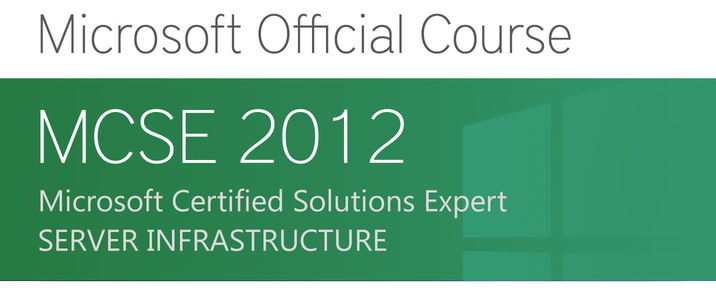- Home
- -
- Microsoft Certification
 ₹ 15,000
₹ 15,000 MCSE — Server Infrastructure
- 30 days Regular Course
- 75 Hours
- 15 days Crash Course
- Networking
COURSE DESCRIPTION
MCSE is a certification option available to IT professionals who work with Microsoft technologies. Certification specializations comprises of server infrastructure, private cloud, enterprise devices and apps, Sharepoint, communication, messaging, data platform and business intelligence. There are tons of advantages incorporated with regard to salary and packages, an MCSE certification holder tend to get.
Information technology revises rapidly, and professionals working in this sector must keep up with the latest developments. Attaining MCSE certification proves you’re well versed with the most recent Microsoft technologies, such as servers and operating systems. Obtaining an MCSE certification can also serve as a stepping stone to other additional certifications.
Course Requirements
Prerequisite courses are not generally required, but a current MCSA is. The MCSE requirements list all necessary exams, along with prerequisite MCSA credentials (of which any one will suffice).
Lab equipments available
- Windows Server 2012 PC
- VMWare
MCSE NEW Syllabus
Installing and Configuring Windows Server 2012 (070-410)
Module 1: Deploying and Managing Windows Server 2012
- Windows Server 2012 Overview
- Overview of Windows Server 2012 Management
- Installing Windows Server 2012
- Post-Installation Configuration of Windows Server 2012
- Introduction to Windows PowerShell
Module 2: Switching Between Server Modes
- Switching the Server GUI to Server Core
- Switching the Server Core to Server GUI
Module 3: Implementing Storage
- Overview of Storage
- Managing Disks and Volumes
- Implementing Virtual Hard Disks
- Implementing Virtual Disks
Module 4: Introduction to IPv4
- Overview of TCP/IP
- Understanding IPv4 Addressing
- Subnetting
- Configuring and Troubleshooting IPv4
Module 5: Introduction to Active Directory Domain Services
- Overview of Active Directory
- Overview of Domain Controllers
- Installing a Domain Controller
- Implementing Domain Member Server and Client
Module 6: Implementing Additional Domain Controllers
- Implementing Additional Domain Controllers
- Operating ADC
Module 7: Managing Active Directory Domain Services Objects
- Managing User Accounts
- Managing Group Accounts
- Managing Computer Accounts
Module 8: Implementing Domain Name System
- Introduction to DNS Service
- Installing and Managing a DNS Server
- Managing DNS Zones
Module 9: Implementing Dynamic Host Configuration Protocol
- Introduction to DHCP Service
- Installing a DHCP Server Role
- Configuring DHCP Scopes
- Managing DHCP Scopes
Module 10: Implementing File and Print Services
- Securing Files and Folders with Share and NTFS Permissions
- Protecting Shared Files and Folders by Using Shadow Copies
Module 11: Implementing Group Policy
- Overview of Group Policy
- Local Group Policy
- Implementing a Central Store and Refresh
- Templates and Central Store
- Delegation and Security Settings
- Scope of Management
Administering Windows Server 2012 (070-411)
Module 1: Deploying and Maintaining Server Images
- Overview of Windows Deployment Services (WDS)
- Implementing Deployment with Windows Deployment Services
- Administering Windows Deployment Services
- Implementing Install From Media (IFM)
Module 2: Configuring and Troubleshooting Domain Name System
- Installing and Configuring the Secondary DNS Server
- Configuring DNS Zone Transfers
- Configuring DNS Load Balancing
- Managing and Troubleshooting DNS
Module 3: Managing User and Service Accounts
- Automating User Account Management (Bulk User Creation)
- Implementing Fine-Grained Password Policies
- Roaming and Mandatory Profiles
Module 4: Implementing a Group Policy Infrastructure
- Policies and Preferences
- Starter GPOs
- Group Policy Rule and Application Enforcement
- Configuring Windows Firewall with Advanced Security
- Group Policy Processing
- Scripts in GPO
Module 5: Optimizing File Services
- Overview of FSRM
- Using FSRM to Manage Quotas, File Screens, and Storage Reports
- Overview of Distributed File System (DFS)
- Configuring DFS Namespaces
- Configuring and Troubleshooting Distributed File System Replication (DFS-R)
Module 6: Configuring Encryption and Advanced Auditing
- Encrypting Files by Using Encrypting File System
- Configuring Advanced Auditing
Module 7: Implementing Update Management
- Overview of WSUS
- Deploying Updates with WSUS
Module 8: Monitoring Windows Server 2012
- Monitoring Tools
- Using Performance Monitor
- Monitoring Event Logs
Module 9: Implementing
Remote Server Administration
- Configuring and Accessing Remote Desktop
- Remote Server Administration Tools
Module 10: Configuring NIC Teaming
- Overview of NIC Teaming
- Configuring NIC Teaming
Configuring Advanced Windows Server 2012 Services (070-412)
Module 1: Implementing Advanced DHCP Services
- Configuring DHCP Failover
- Configuring DHCP Backup and Restore
- Configuring DHCPv6
Module 2: Advanced Group Policy Management
- Software Deployment GPOs
- Backup and Restore GPOs
- Configuring Import and Copy GPOs
- Configuring Folder Redirection
- Printer Preferences
Module 3: Implementing Advanced File Services
- Configuring iSCSI Storage
- Optimizing Storage Usage
Module 4: Configuring and Troubleshooting Remote Access
- Configuring Network Address Translation (NAT)
- Configuring Virtual Private Network (VPN) Access
Module 5: Web Server Management with IIS
- Configuring Internet Information Services
- Hosting Multiple Web Sites
- Integrating FTP into IIS
Module 6: Implementing Active Directory Domain Services Sites and Replication
- Overview of AD DS Replication
- Configuring AD DS Sites
- Configuring and Monitoring AD DS Replication
- Implementing Universal Group Membership Caching (UGMC)
Module 7: Active Directory Maintenance
- Active Directory Snapshot
- Active Directory Defragmentation
- Managing DSRM Password
Module 8: Backup and Restore Operations
- Implementing Windows Server Backup and Recovery
- Active Directory Backup and Recovery
Module 9: Implementing Disaster Recovery
- Overview of Disaster Recovery
- Overview of FSMO Roles
- Transferring and Seizing AD FSMO Roles
Designing and Implementing a Server Infrastructure (070-413)
Module 1: Designing and Implementing IP Address Management
- Overview of IP Address Management (IPAM)
- Planning and Implementing an IPAM
Module 2: Designing and Implementing an ADDS Forest and Domain Infrastructure
- Designing an AD DS Forest
- Designing AD DS Domain Trusts
- Designing and Implementing AD DS Forest Trusts
- Designing and Implementing AD DS Domains
Module 3: Implementing Server Virtualization with Hyper-V
- Overview of Virtualization Technologies
- Implementing Hyper-V
- Managing Virtual Machine Storage
- Managing Virtual Networks
Module 4: Implementing Active Directory Certificate Services
- PKI Overview
- Deploying CAs
- Deploying and Configuring CA Hierarchy
- Deploying and Managing Certificate Templates
- Implementing Certificate Distribution and Revocation
- Managing Certificate Recovery
Module 5: Implementing Active Directory Federation Services
- Overview of AD FS
- Deploying AD FS
Module 6: Implementing Active Directory Rights Management Services
- AD RMS Overview
- Deploying and Managing an AD RMS Infrastructure
- Configuring AD RMS Content Protection
- Configuring External Access to AD RMS
Implementing an Advanced Server Infrastructure (070-414)
Module 1: Planning and Implementing File Services
- Overview of BranchCache
- Configuring BranchCache
Module 2: Installing, Configuring, and Troubleshooting the Network Policy Server Role
- Installing and Configuring a NPS
- Configuring Remote Authentication Dial-In User Service (RADIUS) Clients and Servers
- Overview of Network Access Protection
Module 3: Implementing Network Load Balancing
- Overview of NLB
- Configuring an NLB Cluster
Module 4: Implementing Dynamic Access Control
- Overview of Dynamic Access Control (DAC)
- Planning for Dynamic Access Control
- Deploying Dynamic Access Control
Module 5: Implementing IPv6
- Overview of IPv6
- IPv6 Addressing
Module 6: Planning and Designing Infrastructure
- Setting up the Windows Server 2012 Infrastructure



